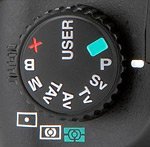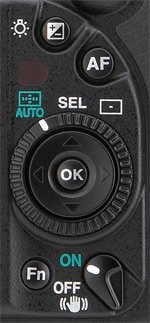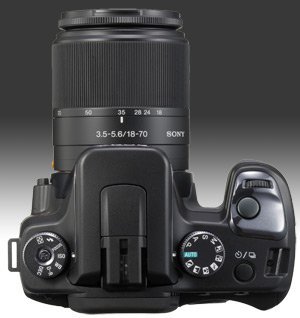10 Megapixels DSLR Cameras Comparison
Since you read this far, there is probably more than one model with the major features that fit your photographic needs. So the final decision is going to be based on minor details. Some of these are quite subjective such as the way a camera body fits in your hands. For those who just landed here, you can review the major differences on the previous page.
Every 10 megapixels DSLR camera covers the ISO 100 to 1600 range. The two Nikon cameras, the D80 and D200, also feature boosted ISO settings from 2000 to 3200. The Sony Alpha A100 features a low-key ISO 80 and a high-key ISO 200 setting. These two settings set the camera's ISO and change the tone-curve to keep more shadow details and more highlight details, respectively. These two special ISO settings of the A100 are quite helpful in dealing with particular scenes.
Except for the Nikon D200, every DSLR compared here as an Auto-ISO setting. The Pentax K10D allows to customize the minimum and maximum ISO allowed. The Canon Rebel XTi's Auto-ISO is fixed from 100 to 400. The Nikon D80's Auto-ISO can be configured by selecting the maximum possible ISOFrom 200 to 1600 and the minimal shutter-speedBetween 1/125s and 1s. The Sony Alpha A100's Auto-ISO is fixed between 100 and 800.
For ISO, the range itself can be misleading. It matters more which are usable ISO settings than which settings can be set on the camera. There is a reason why many cameras, such as the Nikon D80 and D200, hide their extended ISO range. There is also a reason why fixed Auto-ISO settings have a limited range. Normally, going beyond these ranges represents a distinct drop in image quality.
Based on available samples, there are virtually no differences between noise levels until ISO 400 for all these cameras. Beyond that, the Canon Rebel XTi shows the least amount of noise while retaining significant detail. The Sony Alpha A100 shows good detail but the highest visible noise starting at ISO 800. The Nikon D80 shows very little noise but has significant softness at ISO 800 and above. The Nikon D200 is somewhere in between. These results are not surprising considering the same sensor design is used for all these cameras. Not enough information on the Pentax K10D is available at this time.
Naturally, every DSLR here as PSAM modes with program shift to obtain equivalent exposures. The Canon adds an Auto-DOF mode which selects an aperture so that all focus points are in focus. The Sony A100 allows shifting based on aperture or shutter-speeds.
 The Pentax K10D has the most sophisticated set of modes. Its P mode is referred to as hyper-program because it can be shifted into aperture-priority or shutter-priority using the control wheels. A green button is used to instantly return to program mode after shifting. The K10D also features a sensitivity priority which gives direct ISO control using a control wheel. These is also a TA mode which has the camera select an ISO speed based on the selected shutter-speed and aperture. Its M mode is referred to has hyper-manual because the exposure can be preset by spot-metering using the green button. A very useful customization of the K10D is to select wether program modes favor average settings, fast-shutter speeds, narrow apertures or optimal lens sharpness. There is also an X mode which favor the flash sync-speed. These modes are truly outstanding features of the Pentax K10D.
The Pentax K10D has the most sophisticated set of modes. Its P mode is referred to as hyper-program because it can be shifted into aperture-priority or shutter-priority using the control wheels. A green button is used to instantly return to program mode after shifting. The K10D also features a sensitivity priority which gives direct ISO control using a control wheel. These is also a TA mode which has the camera select an ISO speed based on the selected shutter-speed and aperture. Its M mode is referred to has hyper-manual because the exposure can be preset by spot-metering using the green button. A very useful customization of the K10D is to select wether program modes favor average settings, fast-shutter speeds, narrow apertures or optimal lens sharpness. There is also an X mode which favor the flash sync-speed. These modes are truly outstanding features of the Pentax K10D.
White-balance (WB) compensates for the color of various light sources. The outstanding WB feature among these camera is the Pentax K10D's digital white-balance preview. This feature allows to preview the same image using each WB setting with fine-tuning applied. With every other DSLR, finding the right WB setting requires taking multiple shots. Missing from the XTi, compared to the rest of these cameras, is a kelvin WB setting. Note that kelvin white-balance is normally used under studio lights which have a known color-temperature.
| Table 4 - White Balance Controls | |
|---|---|
| Sony Alpha A100 | Auto, Day, Shade, Cloudy, Tungsten, Fluorescent, Flash, Kelvin, Custom 7-levels tuning for Preset 19-levels tuning for Kelvin |
| Nikon D80 | Auto, Incandescent, Fluorescent, Sun, Flash, Cloudy, Shade, Kelvin, Custom |
| Nikon D200 | Auto, 6 Presets, Custom, Kelvin 7-level tuning for Preset 4 Custom memories |
| Pentax K10D | Auto, Day, Shade, Cloudy, 3 Fluorescent, Tungsten, Flash, Manual, Kelvin, Mired Tuning, +/-7 Blue-Amber, +/-7 Magenta-Green |
| Canon Rebel XTi | Auto, Day, Shade, Cloudy, Tungsten, Fluorescent, Flash, Custom Tuning, +/-9 Blue-Amber, +/-9 Magenta-Green |
The standard exposure compensation (EC) range is from -2 to +2 EV in 1/3 stop increments. The Pentax K10D can do a bit better with a -3 to +3 EV range when using 1/2 stop increments. Both Nikon 10 megapixels DSLR cameras have a much better EC range going from -5 to +5 EV. Given that it is probably an easy feature to implement, we wonder why the other cameras do not have it. EC is very useful for tuning exposure without going into manual mode.
 Exposure locking (AEL) and focus locking (AFL) can be done automatically with a half-press of the shutter or triggered using another button. The Canon XTi, Nikon D80 and Nikon D200 all have a single customizable button to perform one of these actions, or both actions at once. Both the Pentax K10D and the Sony Alpha A100 have separate AEL and AFL buttons. With the K10D, the AEL button can meter around the center or around the focus-point. The K10D also allows the AFL button to disable focusActually switching to manual focus, thus emulating Sony DMF. with or without AEL. With the A100, the AEL button can spot-meter instead of using the set metering mode. Again with the A100, the AEL button can also be set to toggle the exposure - that is hold it even after the button is released.
Exposure locking (AEL) and focus locking (AFL) can be done automatically with a half-press of the shutter or triggered using another button. The Canon XTi, Nikon D80 and Nikon D200 all have a single customizable button to perform one of these actions, or both actions at once. Both the Pentax K10D and the Sony Alpha A100 have separate AEL and AFL buttons. With the K10D, the AEL button can meter around the center or around the focus-point. The K10D also allows the AFL button to disable focusActually switching to manual focus, thus emulating Sony DMF. with or without AEL. With the A100, the AEL button can spot-meter instead of using the set metering mode. Again with the A100, the AEL button can also be set to toggle the exposure - that is hold it even after the button is released.
Of all these 10 megapixels DSLR cameras, the K10D, the D80 and the D200 are the ones to feature 2 control wheels. This is a great advantage for users of manual (M) mode where each wheel controls either shutter-speed or aperture. With the XTi and the A100, one parameter is controlled using the wheel alone and the other is controlled using the wheel in conjunction with the exposure-compensation (EC) button. Even in semi-automatic modes, the second wheel can be used to apply EC which makes for quicker changes in exposure. Depending on your usage, having 2 control wheels can be a significant ergonomic advantage.

Self-timers are available with all these cameras. There is at least a short-timer suitable for preventing camera shake during long exposures and a long-timer suitable for getting into group photos. The K10D and A100 automatically lift the mirror when using the short-timer and reset the long timer after each use. This perfectly matches the most common usage of self-timers. The K10D and the D80 also add delayed and immediate remote self-timer options. The K10D allows 2s or 12s self-timers, or 3s with remote. The XTi allows 10s or 3s with mirror-lockup. The D80 and D200 allow 2s, 5s, 10s or 20s self-timer. There is a separate mirror-up button and a time-lapse drive on the Nikon D200.
Although there is nothing you can do with automatic bracketing that you cannot do without, it does save time and mistakes over manual bracketing. Every camera here can bracket at least 3 images for exposure and white-balance. The K10D can also bracket sharpness, saturation and contrast, while the D200 can bracket flash power or flash exposure. Exposure increments are 1/3 to 2 EV for the K10D and D80, 1/3 or 1/2 EV for the XTi, 1/3 or 2/3 EV for the A100 and 1/3 to 1 EV for the D200. Pentax does well by bracketing 3 or 5 images, but the Nikon D200 does better by bracketing from 2 to 9 images. HDR imagery which requires zero camera movement during large bracket sequences is much easier with the Nikon D200 than with any of its competitors. The most sophisticated white-balance bracketing is found on the Canon Rebel XTi and the Pentax K10D. They can both bracket in either blue-amber or magenta-green directions, in 1 to 3 increments.
In addition to bracketing, the K10D, D80 and D200 can perform multiple-exposure images. This is like taking multiple pictures on the same film negative. Having this feature in-camera tremendously increases the chances of obtaining good results from multiple-exposure images. To facilitate the process even more, these cameras all feature auto-exposure adjustment which reduces the chances of producing an over-exposed result. The Pentax can combine up to 9 images, while the Nikon cameras can combine up to 10 images.
All of these cameras feature first-class autofocus (AF) systems. Specifications vary slightly, but they are close to even. Every 10 megapixels camera has single-shot AF, continuous AF and manual focus (MF). These cameras can either automatically select the focus-point, always focus at the center or manually select a single focus point. Except for the K10D and D200, these cameras have an additional mode which automatically selects between single-shot and continuous AF. Both the Nikon D80 and D200 feature subject-tracking which adjusts focus based on subject movement. The Sony Alpha A100 also features a Direct Manual Focus (DMF) mode which automatically enables MF when AF has locked. Note that most ultrasonic lensesLabeled USM or SSM. allow this do be done without the need for DMF.
Focus speed depends on a camera and its lens. Wider-aperture lenses generally focus faster. Since the Canon lens-mount does not feature an AF-coupling, its focus speed is more affected by the lens. With AF-coupling, lens focusing is done by the same motor for all lenses which reduces variations in focus-speeds. The Sony camera only features AF-coupling and therefore we cannot buy fast-focusing ultra-sonic lenses for it.
| Table 5 - Focus Systems | |
|---|---|
| Sony Alpha A100 | 9 points, 8 lines with cross-type, DMF |
| Nikon D80 | 11 normal-areas or 7 wide-areas |
| Nikon D200 | 11 normal-areas or 7 wide-areas, closest-area, group-area, dynamic-select, single-select |
| Pentax K10D | 11 points, 9 cross-type |
| Canon Rebel XTi | 9 points |

